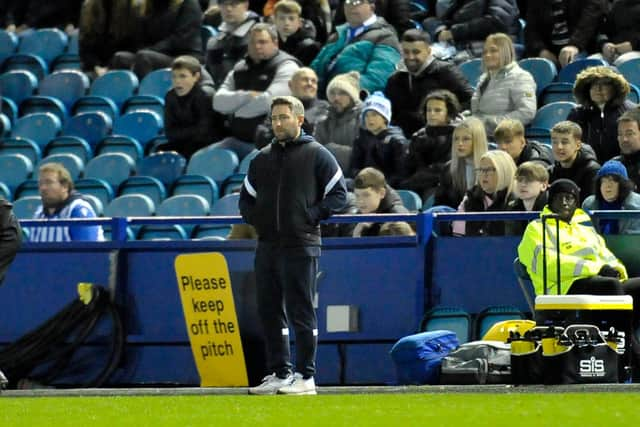The data behind Sunderland's attacking problems and what needs to change ahead of crucial Ipswich Town League One clash
and live on Freeview channel 276
As we head into the international break Lee Johnson’s side find themselves slightly off the pace in the League One promotion race with supporters once again concerned as to whether their side can achieve promotion at what is the fourth time of asking.
Had you asked that question following the 5-0 thrashing of Cheltenham Town at the end of September you’d have been given a much different answer.
Advertisement
Hide AdAdvertisement
Hide AdThat dominant victory over the Robins had Johnson’s side top of the table, three points clear of third placed MK Dons with a game in hand. For once, it looked as though the Black Cats were going to live up to their reputation of being would-be frontrunners at this level.


Fast forward six weeks and Sunderland have won just two of their six league games since, losing their last three on the spin with alarming defeats at both Rotherham United and Sheffield Wednesday, given the severity of each scoreline.
So, the question on everyone’s lips is: what has gone wrong? How can the chants go from ‘We’re top of the league’ - to those chants heard at Sheffield Wednesday, in the space of six games?
Well, let's look at some of the data behind Sunderland’s attacking instincts through the first third of the season to try and put our finger on things.
Advertisement
Hide AdAdvertisement
Hide AdThe first thing which jumps out is Sunderland’s goals for column in that at 25 it is the fewest among the top seven in League One and nine less than leading scorers Ipswich Town.


However, when analysing the Black Cats’ average shots and shots on target per-game, there should be no immediate concern.
According to Whoscored.com Sunderland are averaging 14.3 shots per-game, which is ranked third in the division behind Rotherham and Oxford United. The shots on target average sees the Black Cats ranked second with 5.3 each game. So Sunderland are having enough shots and shots on target per-game, but at the moment are not hitting the back of the net enough to mirror those stats.
So what else can Johnson’s side do? Digging deeper into Sunderland’s approach offers some intrigue when considering their crossing ratio compared to how Johnson sets his team up.
Advertisement
Hide AdAdvertisement
Hide AdOf the 15 games played so far, Sunderland are ranked 13th for the average number of crosses per-game with 18. The rest of the sides in the top six, it’s worth mentioning, are all represented in the top six for this particular category.


Now while crosses don’t necessarily guarantee you goals, if your formation lends itself to utilising the wings more often than not, then crossing the ball more often only seems natural. And when looking at Sunderland’s attacking zones, 37% of their attacks are based down the left of the field with 39% down the right.
What that means is, the likes of Aiden McGeady, Lynden Gooch, Aiden O’Brien, Leon Dajaku, Alex Pritchard and Nathan Broadhead, whichever combination of players are operating in the wide positions, are seeing plenty of the ball.
And something which perhaps negates Johnson’s favouring of playing with width is that of Sunderland’s 211 shots this season, 62% of them have come from in the middle of the pitch.
Advertisement
Hide AdAdvertisement
Hide AdLooking at the data around Sunderland’s goals scored a little further, and of the 25 scored only 14 have come from open play with seven from set pieces. Perhaps not an unreasonable ratio, but when you consider Sunderland are ranked third for most times fouled per-game at 12.5 you wonder whether their ranking of fifth when it comes to goals scored from set pieces could be improved?


But maybe those set pieces are coming from deep inside their own half which brings us to another potential issue.
As it stands, Sunderland see most of the ball in the middle third with 39% of their touches in games coming in that area of the field.
However, given Johnson’s philosophy of wanting to play out from the back, the Black Cats are seeing the ball 33% of the time in their own third. Ultimately, you can’t score goals from your own half of the pitch.
Advertisement
Hide AdAdvertisement
Hide AdWhere it matters, Sunderland have just 27% of their play in the opposition third which may tell us a lot as to why one of the most common themes in recent weeks has been just how isolated Ross Stewart has been at the top end of the pitch.
However, it’s not just a tactical approach in terms of possession and wing play or a lack of touches in the opposition third which may be limiting Sunderland’s bite in front of goal.
All told, players still need to be able to contribute and put the ball in the back of the net, or at least test the goalkeeper and beyond Stewart, the Sunderland squad is lacking.
As per FBREF, Scotsman Stewart has registered 20 of the Black Cats’ 78 attempts on target this season - which isn’t necessarily surprising given that he is the focal point of the team.
Advertisement
Hide AdAdvertisement
Hide AdMore worrying for Johnson is that next on the list is Carl Winchester, who has been Sunderland’s right back this season, with seven attempts on target.
Going forward, it’s clear that Johnson must look to utilise his squad’s strengths more by crossing the ball more often if you are adopting a wing based approach.
The Black Cats need to see more of the ball in the final third of the field and some of Sunderland’s array of attacking outlets must start shouldering some of the responsibility away from Stewart when it comes to both goals and attempts at goal.
Broadhead could be an option given that he has averaged 2.29 shots per game over his five appearances this season while also a variety of formation from Johnson’s preferred 4-2-3-1 system could be a possibility in order to get more bodies around Stewart.